A Primer on Fluorescent Minerals
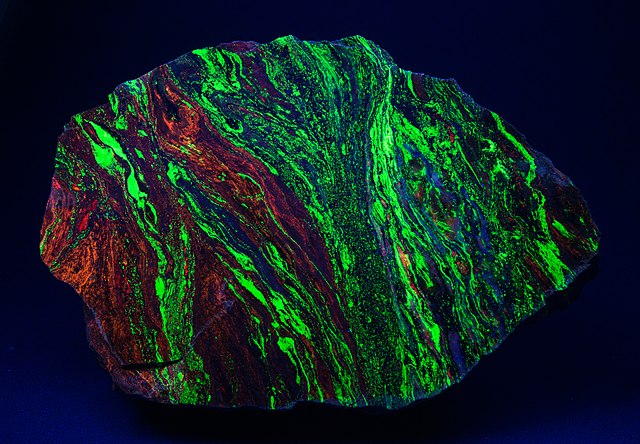
Fluorescing Willemite from Sweden. CC Licensed image by Dr. Hannes Grobe
What Fluorescence Is
Fluorescent minerals in rocks and crystals, just as in many paints or toys, can appear to glow with stunning brightness when exposed to what, for us, is dim or invisible light from ultraviolet (UV) lamps or even other wavelengths including x-rays. They can appear to the human eye as though they are reflecting more light, and in a different color, than you are emitting them. Technically they absorb light of one wavelength or color and emit some light in a different wavelength or color. If we could see UV as well as day-glow green, for example, the effect, above, would be far less remarkable. In reality, it’s emitting less energy than it’s absorbing. Our own inability to perceive UV light gives it the illusion of radioluminescence (a glow caused by ionizing radiation interacting with matter). Different UV light-triggered fluorescent minerals respond (or not) to various wavelengths of UV. While some respond to common black light (a particularly long-waved section of UV-A band) many respond better or only to shorter wavelengths such as UV-B or even UV-C (the shorter the wavelength and higher the wattage the more protective glasses are called for).
What Fluorescence is Not
Fluorescence is not the same as phosphorescence. Phosphorescent minerals continue to emit light for a while after the responsible light source is switched off or removed, whereas fluorescent minerals stop emitting as soon as the source is removed. While these two terms and others represent different properties, some minerals may possess multiple properties at once. Some may be subsets of others, such “fluorescent” and “phosphorescent” being subsets that fall under “luminescence”. Luminescence means emitting light without being heated to the point of incandescence, and incandescence usually means something is on the verge of burning up, like the filament of a classic light bulb.
On that note, fluorescence is also not the same as other luminescent properties such as that of thermoluminescent minerals. These can emit light when heated, but often far less than enough to become incandescent. Imagine lining a campfire with rocks and finding they “come alive” from the heat and start glowing in beautiful patterns like something from science fiction! It happens:
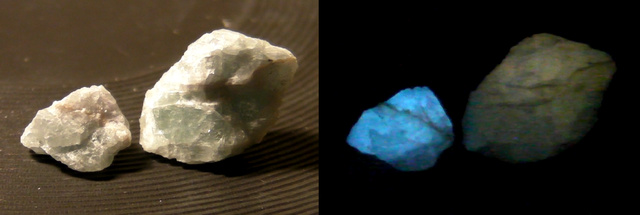
Fluorite, one more visibly thermoluminescent than the other. CC licensed image by Mauswiesel
Many fluorescent minerals are also not necessarily radioluminescent, although some of the most vibrant, fluorescent hues incidentally come from materials containing radioactive uranium, such as autunite, otherwise known as calco-uranite or calcium uranyl phosphate, and sometimes described as uranium mica according to its lamellar or layered nature.
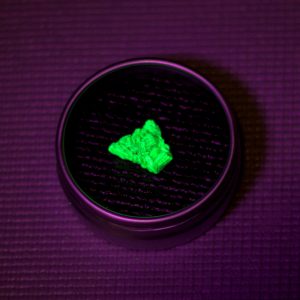
Autunite fluorescing under long UV-A black light
Other types of luminescence in minerals exist aside from fluorescence, such as triboluminescence, the emission of visible light as a result of mechanical action such as being struck or crushed. Triboluminescence is related to piezoelectricity, where electricity is voltage is generated from crystals being struck or placed under pressure such as is utilized in press-button or “clicker” ignitors for lighters and gas stoves.
Identifying Fluorescent Minerals !
Below is a phenomenal photo of a collection of fluorescent minerals by Dr. Hannes Grobe using all three bands of UV light combined. Below the images is a numbered, fluorescent minerals list corresponding to the numbers in the black & white indicator chart. Special thanks to Dr. Grobe and his licensed provision of such a fun resource through Creative Commons:
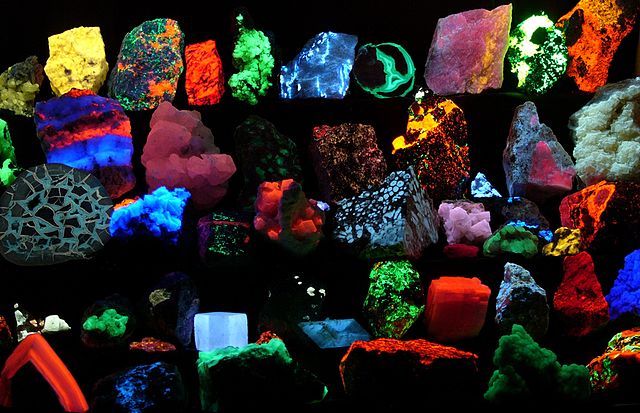
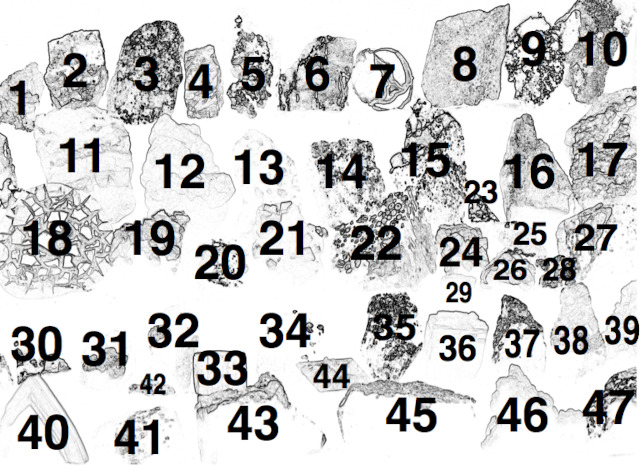
1. Cerussite, Barite – Morocco
2. Scapolite – Canada
3. Hardystonite (blue), Calcite (red), Willemite (green) – New Jersey
4. Dolomite – Sweden
5. Adamite – Mexico
6. Scheelite – unknown origin
7. Agate – Utah
8. Tremolite – New York
9. Willemite – New Jersey
10. Dolomite – Sweden
11. Fluorite, Calcite – Switzerland
12. Calcite – Romania
13. Rhyolite – unknown origin
14. Dolomite – Sweden
15. Willemite (green), Calcite (red), Franklinite, Rhodonite – New Jersey
16. Eucryptite – Zimbabwe
17. Calcite – Germany
18. Calcite in a Septarian nodule – Utah
19. Fluorite – England
20. Calcite – Sweden
21. Calcite, Dolomite – Sardinia
22. Dripstones – Turkey
23. Scheelite – unknown origin
24. Aragonite – Sicily
25. Benitoite – California 26. Quartz Geode – Germany
27. Dolomite, Iron Ore – Sweden
28. Unknown
29. Synthetic Corundum
30. Powellite – India
31. Hyalite opal – Hungary
32. Vlasovite in Eudyalite – Canada
33. Spar Calcite – Mexico
34. Manganocalcite(?) – Sweden
35. Clinohydrite, Hardystonite, Willemite, Calcite – New Jersey
36. Calcite – Switzerland
37. Apatite, Diopside – USA
38. Dolostone – Sweden
39. Fluorite – England
40. Manganocalcite – Peru
41. Hemimorphite with Sphalerite in gangue – Germany
42. Unknown from Långban, Filipstad, Sweden
43. Opal – origin unknown
44. Selenite gypsum – origin unknown
45. Dolomite – Sweden
46. Chalcedony – unknown origin
47. Willemite, Calcite – New Jersey
